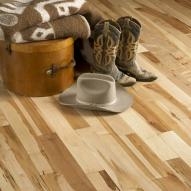Engineered Maple Flooring
 A common species throughout North America, maple has a light appearance of cream-colored sapwood and white to reddish-brown heartwood. Most commercial maple flooring, however, comes from trees from the eastern United States and Canada.
A common species throughout North America, maple has a light appearance of cream-colored sapwood and white to reddish-brown heartwood. Most commercial maple flooring, however, comes from trees from the eastern United States and Canada.
Also referred to as "sugar maple," domestic maple flooring has closed grain with medium figuring, which gives the wood a cat eye appearance. Maple flooring with more figuring is typically assigned a higher grade. Grading for maple hardwood is different than that for other domestic species. First is the highest grade for maple flooring, and the wood, free of character marks, is white and pink with a curly figure. Second, the next grade down, displays some knots, while character marks have a greater presence on Third grade maple flooring. Contemporary terminology for maple flooring may use Select #1 and Select #2.
One of the harder domestic species, maple hardwood has a 1450 Janka scale rating and is stiff, strong, dense, and abrasion resistant. These properties provide good shock resistance and holding ability and make the wood resistant to splitting, but machining maple hardwood can be a challenge. Sanding and finishing, however, present less difficulty.
The density and durability make maple hardwood flooring ideal for high-traffic arenas. Ideal for such spaces in your home, maple hardwood is also commonly found in areas for sports activities, such as bowling alleys or roller rinks.
Maple flooring is sold in solid and engineered varieties. The latter of these two provides a few advantages in installation. Engineered maple flooring expands and contracts less than its solid counterpart and, because of this quality, can be placed on, above, or below grade.
To have this stability, engineered maple flooring is constructed out of three to nine layers, or veneers, of hardwood bonded together. High-quality maple flooring is on top, and all below are of the same or different species. The grain on each layer, as well, faces a different direction. Because these features reduce expanding and contracting, engineered maple flooring can be placed over radiant heat, concrete, or in many locations with humidity or high temperatures.
Available as prefinished or unfinished hardwood, engineered maple can be stapled or glued down or floated above a subfloor. If you choose unfinished engineered maple, however, make sure the flooring has a thick wear layer, which allows engineered hardwood to be finished just as many times as solid. Engineered flooring is 1/4ths to 3/4ths of an inch thick, and the wear layer is 0.6mm to 3/16ths of an inch thick.
